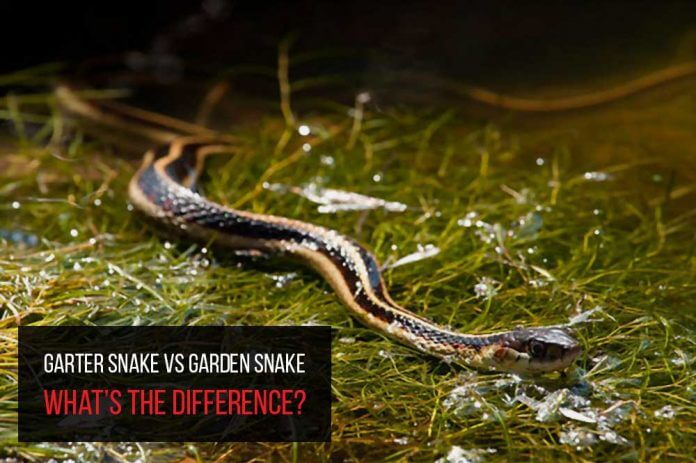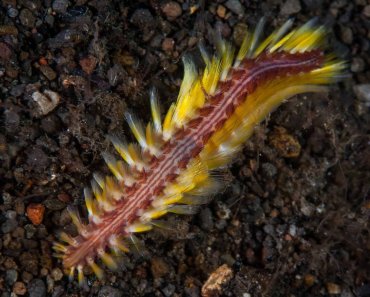Garter snake, garden snake… what’s the difference? Are they entirely the same? The purpose of this guide is to dispel any myths and clear up any confusion about these common, North American snakes.
What’s the difference between a garden snake and a garter snake? The short answer is… they are the same! They are simply two names for the same snake, the more common name being garter snake. But the question remains, how did the garter snake become the garden snake, and why does it matter?
So the basic question is simple: they are merely two names for the same species of snake. In fact, the common name is garter snake. It seems to be that ‘garden snake’ is something of a false name, or metonym, used because of the unfamiliarity of the word ‘garter’.
Here are some more questions you will learn the answers to in this guide!
- How did garter snake become garden snake? What’s the connection?
- What does a garter snake look like?
- Where are garter snakes usually found?
- Are garter snake bites poisonous?
- Are garter snakes useful, or are they considered pests?
If, as you’re reading, you come across something you don’t understand, or there’s something you would like to share, please write it in the comments below! For now, on with the show…
How did the garter snake become the garden snake?
So, we have established that ‘garden snake’ is just an alternative name for the garter snake, which is a small to medium-sized snake belonging to the genus Thamnophis. But why do people call them garden snakes? Can it be narrowed down to a clear, simple reason?
Well, possibly. The most convincing explanation is that, owing to their adaptability and wide-ranging habitat choice, they often show up in gardens. They are also found in a bunch of other places – more on them later.
Add to this the fact that the word ‘garter’ already resembles ‘garden’, and is relatively unusual, and seldom used in daily conversation. The result? A clear path to garter snakes being colloquially misnamed as garden snakes.
Well, perhaps misnaming is too harsh a word. It seems that people often use the term ‘garden snake’ as a general name for those harmless snakes they see looking after their garden.
What does a garter (or garden) snake look like?
Garter snakes (or, if you’d prefer, garden snakes) are small to medium-sized snakes. They belong to the genus Thamnophis, are proud bearers of the title of state reptile of Massachussetts.
They vary in size from about 18 to 54 inches, or 46-137 cm. Garter snakes typically weigh around 5 ounces, or 140g. There is ongoing dispute over whether or not they share enough genetic code with the genus Nerodia, or water snakes, to be grouped together with them genetically. Subspecies of each have been moved back and forth between the two genera.
In terms of coloration, garter snakes come from a fairly broad range of colors and patterns. Most common garter snakes have a pattern of yellow stripes on a dark green, brown or black background. But there are other types of garter snake, too, with red, yellow and/or white patterns running the length of their bodies.
Some boast vivid, garter-like patterns, whereas others are more modest in their coloration. The full range can be seen across the United States, so next time you go for a walk in the country, see if you can spot one!
Where are garter or garden snakes usually found?
Garter snakes are endemic to North America. They can be found in just about every state, as well as parts of southern Canada and Central America – from the subarctic plains of Canada right down towards Panama.
When it comes to habitat, these snakes are not particularly fussy. They have wide distribution (in terms of variance, as well as geography) due to their varied diets and adaptability to a broad range of habitats.
The misnomer ‘garden snake’ is actually a pretty good clue. As it’s a name popularized by people who don’t know too much about herpetology, it’s an indicator of where you might find garter snakes.
The significance of water in ensuring garter snake adaptability
One of the key factors which plays into their high level of adaptability is their embrace of locations with varying proximity to water. Many snakes require a lot, or live best in very dry areas. It is those who can adapt to wider ranges of water availability that manage to spread themselves most effectively.
A point worth adding, in relation to water proximity, is that the garter snakes that inhabit western parts of North America are more aquatic than those in the eastern portion.
Garter snakes populate a variety of habitats, from forests, woodlands and jungle to fields, lawns and grasslands. They never like to be too far away from a water source, and therefore often inhabit areas adjacent to wetland, ponds, streams or rivers. This reflects the fact that one of their favorite meals is… amphibians!
How do you spot a garter snake?
No snake flaunts its presence, unless it is under threat. Snakes are typically secretive, solitary animals, so they can often be tricky to spot. However, look closely, and you might see something wriggling around in the grass.
Where are they mostly found? First, make sure you are near a freshwater source. Garter snakes will never be very far away from water—they are adaptable, but they still have certain basic needs! Because garter snakes mostly consume amphibian life forms, they are most often found close to water.
Think like a predator
Next, keep in mind that they need safe places to hide—in bushes, under rocks, or among foliage. Fallen trees and small caves may well house garter snakes, or other serpentine creatures. Also, bear in mind that the garter snake’s primary predators are predominantly birds of prey, such as crows, egrets, herons and cranes.
Raccoons, otters and other snake species, such as king snakes and coral snakes, also prey upon garter snakes. For this reason, you may be more likely to spot a garter snake if you can think like one of their predators. Keep still, keep quiet; keep an eye on the open spaces they have to pass through to get where they’re going. That way, you’re more likely to spot them unawares.
Are garter snake bites poisonous?
Garter snakes were long thought to be nonvenomous. However, recent discoveries (in the early 2000s) revealed that they do in fact produce mild neurotoxic venom. The good news? They don’t produce very much, and it isn’t very strong.
They also lack an effective means of delivering their venom except on small animals with easily perforated skin. In a few rare cases, there have been reports of bruising and swelling. But this is certainly not a snake you need to worry about.
Can they harm humans?
If disturbed, a garter snake may coil and strike. However, it is more likely to hide its head and flail its tail. They have also been known to discharge a malodorous, musky-scented secretion from a gland near the cloaca. This behavior is perhaps most recognizable to skunks, but snakes do it too.
These are among the techniques used by garter snakes to escape predators. They will also slither into water to escape the snare of a land-based predator.
You should gather from all this that garter snakes are not typically confrontational. This means that, even before we start talking about whether or not they are venomous, you shouldn’t worry too much about being attacked by a garter snake. They are diminutive, not particularly aggressive, and are certainly not known for attacking humans.
Are garter snakes useful or are they considered pests?
Snakes can be frightening. There’s no denying that! But despite the reputation that many snakes have in different parts of the world, many snakes are actually beneficial to human populations. Whether it be the corn snake, which gets its name from its fabled role in protecting corn stores from rodents, or one of the myriad other North American snake species, there are plenty of examples of snakes and humans coexisting in harmony. So, are garter snakes among those?
The answer is… yes! While they do not have a particular reputation for being garden assistants, they can be very useful in reducing certain pest populations from your garden. Here’s why:
- Garter snakes are carnivores. They only eat meat. This means they won’t nibble your lettuce, or chomp your cucumbers. This doesn’t necessarily make them handy to have around, but it certainly reduces their peskiness.
- They are not dangerous to humans. Their venom is weak and produced only in small quantities. They also lack a viable way to deliver it through human skin. Again, this doesn’t make them particularly useful, but it minimizes the risk they pose!
- The garter snake’s diet mostly consists of slugs, earthworms, leeches, lizards, amphibians, minnows and rodents. While earthworms can be useful in maintaining healthy soil, the majority of these animals can at least partially be considered pests.
- They help to keep down rodent populations, and they eat the slugs that eat your lettuce. While they may also eat those cute little frogs in your pond, that might just be a worthy sacrifice to make for a thriving vegetable patch!
Final Thoughts
You set out with the question of whether garter snakes and so-called ‘garden’ snakes are different or the same. Did you get your answer?
With any luck, you got the answers you were looking for, and then some. Garter snakes are fascinating animals, just like all other snakes. They are the secret park rangers, slithering through the grass and looking after your vegetable and fruit gardens.
As you can see, there is always much to be learned about the world of snakes! And there are oftentimes misconceptions about the dangers posed by snakes.
Do you have garter snakes in your garden? Let us know in the comments below. And as always, feel free to share this guide with anyone you know who needs a quick lesson in the naming of snakes!


























